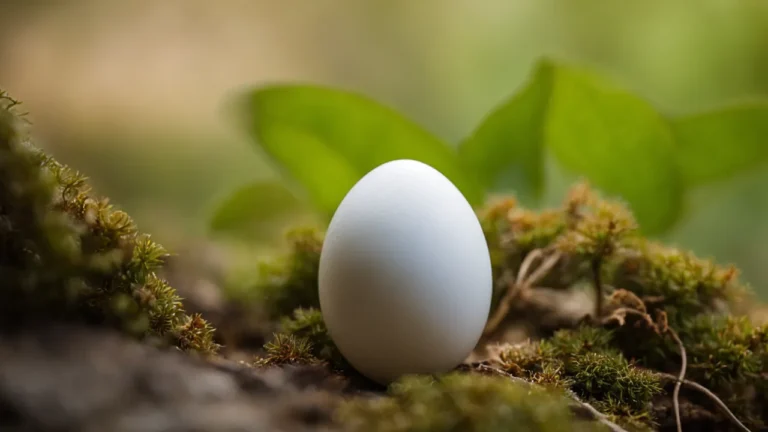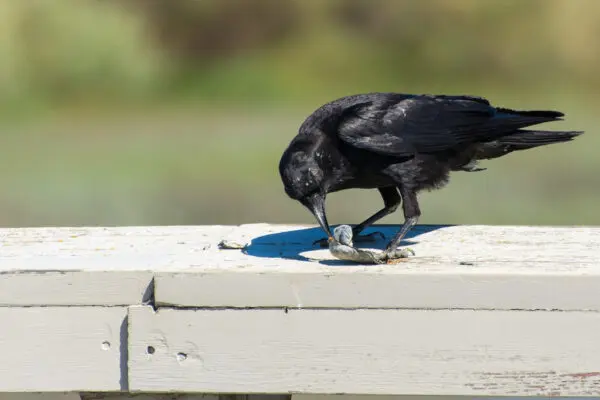One is curious about whether a bird egg that has been found intact has life. A thorough study of avian reproductive biology, patience, and close observation is necessary to determine if a bird egg is alive or not.
For those with limited time, the following is a brief response to your inquiry: To tell whether a bird egg is alive and growing, look for development indicators such as vessels, listen for peeping, feel for movement, and keep an eye on mass changes and heat.
To assist you in understanding how to determine if a bird egg is alive, we’ll go over bird egg viability testing methods, incubation processes, phases of embryonic development, and more in this extensive tutorial.
Study the Biology of Eggs and Avian Reproduction.
When attempting to ascertain the viability of a bird egg, knowledge of avian reproductive and egg biology is essential. The three stages of avian reproduction are egg laying, incubation, and hatching. Bird eggs are special structures that provide the growing embryo all the nutrition and protection it needs.
You may learn a lot about a bird egg’s viability by looking at its exterior structure and contents, comprehending the phases of incubation, and investigating methods for candling eggs.
Examine the External Egg Contents and Structures.
An examination of a bird egg’s exterior and contents may provide important information regarding its viability. Depending on the kind of bird, the egg may have a wide range of shapes, sizes, and colors. Certain eggs could have distinct markings or patterns that act as concealment.
In addition, calcium carbonate, which gives strength and protection, makes up the egg’s shell. By closely examining these exterior features, you may learn vital details on the egg’s condition.
Furthermore, important details about a bird’s growth might be discovered by looking inside one of its eggs. The yolk should be whole and well-formed as it is the growing embryo’s main source of nutrition.
Any odd coloring or the presence of blood vessels on the yolk may be signs of possible developmental problems with the embryo. You can determine if the egg is alive by carefully examining its exterior structures and contents.
Recognize the stages of incubation
Determining the viability of a bird egg requires an understanding of the incubation phases. The procedure via which the parent bird supplies the required warmth to aid in the growth of the embryo is known as incubation. The kind of bird may affect how long the incubation takes.
You may find out whether the egg is inside the anticipated hatching window by being acquainted with the precise incubation times for various bird species.
The embryo passes through many phases of development during incubation. These phases involve the development of organs, the division of cells, and the creation of feathers. You can determine if an egg is advancing through the phases of incubation by monitoring changes in the look and contents of the egg, such as the existence of an air cell or the movement of the embryo.
You may use this information to assess if the egg is viable and growing according to plan.
Investigation Methods for Candling Eggs
One useful method for determining if bird eggs are viable is to candle them. Using this technique, the inside structures of the egg are examined by shining a strong light through it. You may then see whether there are any anomalies, development indicators, and blood vessel existence.
Early on in the incubation process, when outward changes may not be evident, candling can be very helpful in identifying whether an egg is alive.
Eggs may be candied in a number of ways, such as using an egg candler, torch, or even an app on a smartphone. To have the best visibility, candling should be done in a dimly light space.
Through study and practice, you will become more adept at determining the viability of a bird egg.
Look for the First Symptoms of Life
There are a few preliminary indicators you may search for to see whether a bird egg is viable. You can determine whether or not the egg includes a growing embryo by looking for these indicators. You may learn more about the viability of the egg by examining and evaluating these indicators.
Pay Attention to Any Pipping or Peeping Sounds
Listening for pipping or peeping noises is one way to tell whether a bird egg is alive. Pipping is the process by which the bird within the egg starts to use its beak to fracture the shell. Sometimes, this sounds like a light tapping or chirping.
It’s crucial to remember that not every species of bird will produce these noises, thus it may not always apply. If you do hear these noises, however, it’s a strong sign that the egg is viable and the bird is actively attempting to hatch.
Seek out Embryonic Motion.
Examining the embryo for movement is another method of determining if a bird egg is living. You may see this by shining a bright light through the shell or by gently moving the egg between your hands. It indicates that the embryo is alive and growing if you see any little movements or shadows within the egg.
But remember that not all bird eggs—especially in their early stages of development—will exhibit obvious indications of movement.
Check for Shifts in Weight
Feeling for weight changes is another way to determine whether a bird egg is viable. The yolk will provide nourishment to the developing embryo, which will result in the egg progressively losing weight. You may determine if the embryo is alive and developing by periodically weighing the egg and monitoring any changes.
It’s important to remember that this strategy works best for seasoned users who are acquainted with the normal weight fluctuations seen in the eggs of various bird species.
It’s crucial to keep in mind that figuring out if a bird egg is alive isn’t always simple. Certain eggs could not exhibit overt indications of life, and there are also cases when supposedly viable eggs fail to hatch.
It’s usually preferable to get further advice from a wildlife rehabilitation facility or a competent specialist if you are doubtful.
Examine the egg from the inside out.
Examining the egg from the inside out is crucial when attempting to establish if a bird egg is alive. You may have a better understanding of the egg’s viability by looking at several parts of it. The following techniques may be used to evaluate the state of the egg:
Light the Egg to See Growth
Candling is the process of passing a strong light through an egg to see what’s within. Using this technique, you may see if the egg is growing or moving at all. Holding an egg against a strong light source and rotating it gently is how you candle it.
Keep an eye out for developmental indicators like veins or movement. It’s probable that the egg is alive if you see these signs.
Check Airspace for Modifications
The air space within the egg varies as the bird embryo grows inside of it. You can tell whether the egg is alive by keeping an eye on the airspace. You may use a procedure known as “float testing” to do this. After adding water to a container, carefully insert the egg inside.
The egg may no longer be viable if it floats with the little end up and there is a noticeable air gap. Nonetheless, the egg is probably still alive whether it floats horizontally or stays at the bottom.
Evaluate the condition of the shell.
There are hints about the eggshell’s viability that may also be found in its state. The shell of a healthy, live egg is typically smooth and unbroken. The shell may be a sign that the egg is dead if it is fractured, discolored, or has strange textures.
A bad smell coming from the egg might potentially indicate that it is not viable. When evaluating the egg’s shell condition, keep in mind that touching the egg roughly might injure an embryo that is still growing.
It is crucial to remember that these techniques are not infallible and cannot always provide precise results. It is preferable to speak with a wildlife specialist or an experienced avian doctor if you are unsure whether a bird egg will hatch.
They’ll be able to offer you advice and information that is more accurate.
Sustain Adequate Incubation Environment
An egg laid by a bird must be incubated under ideal circumstances in order to be determined to be viable. You may improve the odds of a successful hatch by establishing an atmosphere that closely resembles the circumstances in which the egg would normally be incubated. Here are some important things to think about:
Maintain Consistent Temperature Control
An ideal temperature must be maintained for the development of a bird embryo. It’s crucial to learn about the particular temperature requirements of the bird eggs you are incubating since various species have distinct demands.
For the majority of bird eggs, a temperature range of 99–101 degrees Fahrenheit (37–38 degrees Celsius) is appropriate. Regularly check the temperature using a trustworthy thermometer and adjust as necessary.
Recall that even minute variations may have a big effect on the eggs’ viability.
Assure Proper Humidity and Airflow
For bird embryos to grow properly, there must be enough ventilation and humidity. Oxygen deficiency may be caused by inadequate ventilation, whereas bacterial development and damaged eggshell integrity can be caused by high relative humidity. For the majority of bird eggs, a humidity level of 40–50% is ideal.
This may be accomplished by measuring the humidity levels using a hygrometer and making the necessary adjustments. Additionally, make sure the incubator is properly ventilated to keep the growing embryos’ fresh oxygen supply intact.
Rotate Eggs Occasionally
Regularly turning bird eggs is essential to ensuring healthy development and preventing the embryo from adhering to the inner membrane of the shell. This is in line with the way parent birds naturally turn their eggs many times a day.
To guarantee that the embryo gets the same amount of heat distribution and nutrients from the yolk, gently rotate the eggs 180 degrees, at least three times a day. You can identify which eggs have been rotated by marking one side with a “X” and the other with a “O.”
Maintaining a regular turning schedule is crucial since erratic turning may cause defects or possibly the embryos to die.
Recall that maintaining ideal incubation conditions is essential to the growth and viability of bird eggs. It is usually advised to seek guidance from knowledgeable bird breeders or consult trustworthy websites like www.backyardchickens.com if you have any questions about any element of incubation.
Recognize When to End Incubation
Although it may be a fun and fulfilling experience, it’s crucial to know when to give up on incubating bird eggs. An egg is no longer viable and has to be taken out of the incubator based on a number of indicators.
You can protect the developing embryos’ health and safety and raise the likelihood of successfully hatching healthy chicks by being aware of these indicators.
Identify eggs as early deaths of embryos
It is not unusual for some eggs to not develop throughout the incubation period. We refer to these eggs as early embryonic fatalities. After a certain amount of incubation time, the eggs may be carefully examined to identify them.
It’s probable that the egg is not alive if it shows no symptoms of development, such as blood vessels or movement. To protect the health of the remaining eggs, mark them as early embryonic fatalities and take them out of the incubator.
Throw Away Eggs That Don’t Develop
It’s critical to keep a careful eye on the eggs during the incubation phase to look for any indications of development. Once a significant length of time has passed and there are no indications of growth, the eggs should be removed.
Candling the eggs is a method of seeing the contents of the shell by shining a light through it. It is reasonable to conclude that the egg is not living if there are no outward indications of a developing embryo.
To create place for healthier eggs and to guarantee that the incubator’s ventilation and temperature are regulated properly, discard these eggs.
Whole Term for Incubated Chicks
Conversely, if an egg begins to grow and moves toward hatching, it must be given the opportunity to develop to the full term. This entails giving the developing chick the required attention and assistance in addition to keeping the incubator at the proper temperature and humidity conditions.
It is essential to remember that hatching might take a while, so unless there are obvious symptoms of discomfort or difficulties, you should avoid interfering. Giving the egg the freedom to finish its incubation cycle naturally will maximize the chick’s chances of survival.
Recall that monitoring and attentive care are necessary during the incubation of bird eggs. You may raise your odds of successfully hatching healthy bird chicks by recognizing when to terminate incubation, noting early embryonic deaths, removing non-developing eggs, and enabling hatched chicks to live to full term.
You may visit reliable websites like https://www.backyardchickens.com/ or https://www.birds.cornell.edu/home/ to learn more about the incubation process of bird eggs.
Final Thoughts
Vigilant surveillance, candling, incubation care, and knowledge of avian biology are necessary to determine the viability of bird eggs. Keep an ear out for any indications of life, set up the right environment, and be ready to end the needless incubation process gently.
With practice, you’ll be able to determine with certainty if bird eggs contain live embryos.






